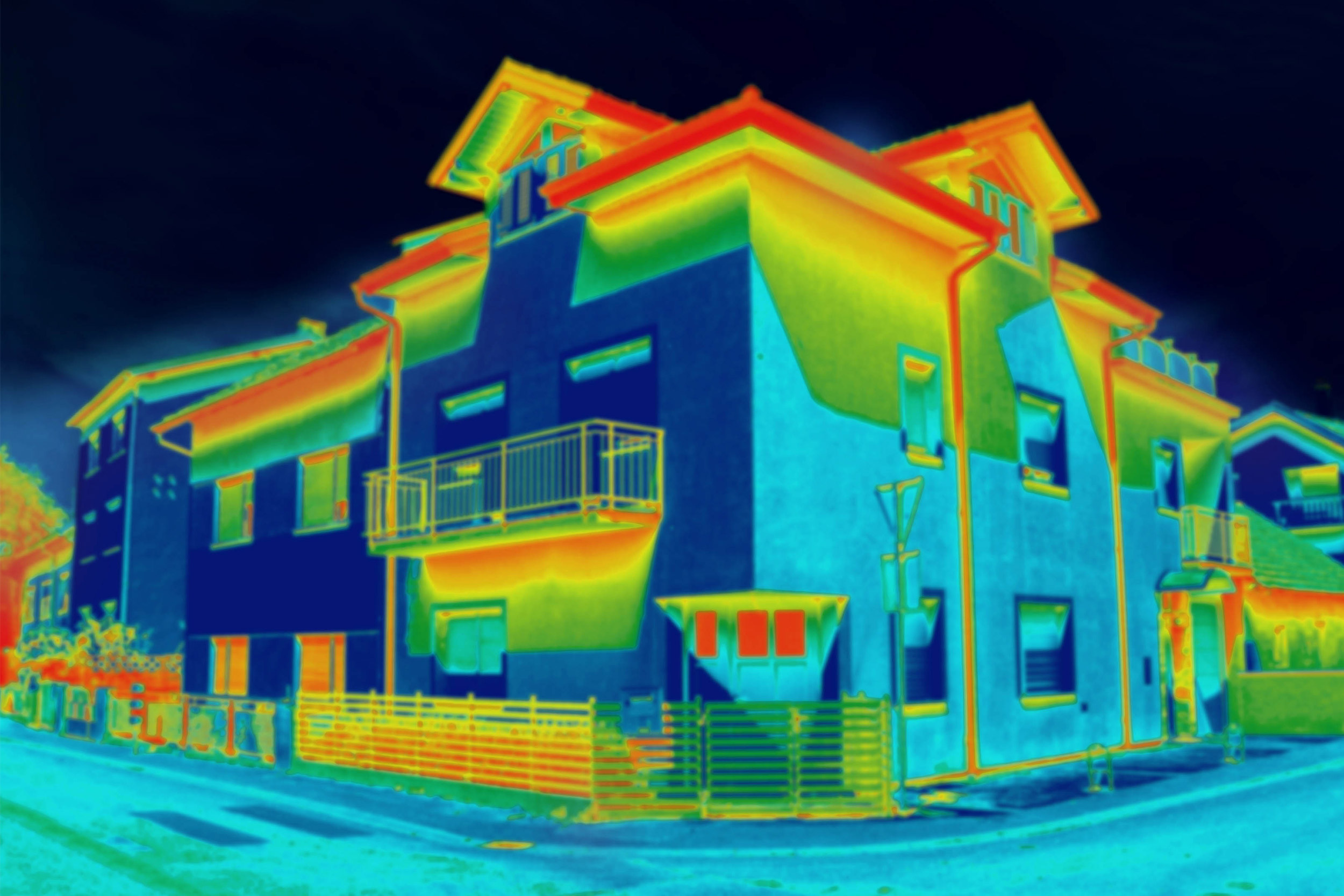
With heating and cooling consuming more than 50 percent of a home’s energy use, buildings, energy efficiency, and climate change are the focus of two of the winning projects. This thermovision image shows heat being released from a house that lacks sufficient insulation.
iStock
Tackling climate change through study
Seven research projects will share $1 million in grants
Seven research projects in the sciences, social sciences, and humanities will share about $1 million in the fifth round of grants awarded by the Climate Change Solutions Fund (CCSF), an initiative encouraging multidisciplinary research projects that seek creative solutions to climate change.
“Harvard has a responsibility to create knowledge and advance research on the pressing issue of climate change,” said President Larry Bacow. “Since its inception, the Climate Change Solutions Fund has supported groundbreaking work across the University, and this year’s cohort represents the complex, multidisciplinary work required to address profound environmental changes that affect all of us.”
“The CCSF Review Committee and I are delighted with this year’s awards,” said vice provost for research Richard McCullough, whose office administers the fund. “The combination of the varied research in which our faculty and students engage — projects in chemistry, economics, anthropology, architecture, and more — and the support shown by University leadership through CCSF ensures the kind of innovative problem-solving we require around climate change.”
In 2014, President Emerita Drew Faust announced the creation of the fund to accelerate the transition from carbon-based energy systems to renewable ones to create a greener world. To date, more than 40 CCSF projects have received more than $5 million. They have included a wide range of topics, including the creation of a new electrochemical method of capturing carbon dioxide to reduce overall levels in the atmosphere, technological advances to lower the cost of solar energy, partnering with local government agencies to address air pollution in India, modeling local economic impacts of extreme weather events, and targeting the emissions associated with food waste.
The fund’s evaluation committee targets projects representing the range of academic disciplines and research interests across Harvard’s 12 Schools. Special consideration is given to projects seeking to use the campus as a living laboratory to test ideas or produce new insights through the lens of nontraditional disciplines, including the arts and humanities. The fund is supported by the president’s office and the generosity of alumni and others.
Here are this year’s seven projects.
Heat Stress, Labor Fatalities, and Adaptation Policy
Patrick Behrer, Harvard Environmental Economics Program Pre-Doctoral Fellow, Ph.D. candidate, Harvard Kennedy School, Graduate School of Arts and Sciences
Exposure to extreme heat has substantial adverse consequences for workers, from acute health conditions to impaired cognitive function. Despite its significance to the U.S. workforce, only a few studies examine the impact of heat on workplace injuries and fatalities, and they all look only at injuries directly attributed to heat, overlooking its indirect effects and underestimating its true impact. This project will assess exposure to extreme heat and how it relates to workplace injuries and fatalities, and will seek to understand how the effects of heat exposure vary by workers’ occupation, race, and socioeconomic status. By measuring the effectiveness of an existing policy to protect workers from extreme heat, this project aims to inspire new legislation to mitigate the impact of heat on the U.S. workforce.
Behrer will be joined by R. Jisung Park in this project. Park earned his Ph.D. at Harvard in 2017 and was an inaugural CCSF awardee for his research project, “The Critical Moment: Climate Means Versus Extremes in the Economics of Climate Change.”
Pleistocene Park: Mitigating the Effects of Climate Change in the Russian Arctic
Anya Bernstein, John L. Loeb Associate Professor of the Social Sciences, Faculty of Arts and Sciences
This project will advance a climate change mitigation experiment in Pleistocene Park, a unique nature reserve in Arctic Siberia that sits on permafrost, which has a considerable impact on climate change due to the high levels of carbon trapped in the frozen soil. By combining ethnographic and archival methods, the investigator will examine the complex historical, sociopolitical, and cultural contexts that shape interactions between humans, animals, and the environment in Pleistocene Park. The project will also investigate the development of biotechnologies in climate engineering while promoting Russian-American cooperation in counteracting the effects of climate change through permafrost preservation.
Measuring the Gains From Trade in a Market for Decentralized Renewable Energy
Shefali Khanna, Harvard Environmental Economics Program Pre-Doctoral Fellow, Ph.D. Candidate in Public Policy, Harvard Kennedy School, Graduate School of Arts and Sciences
Decentralized solar energy technologies have significant potential for increasing energy access while achieving climate change mitigation goals, particularly in the developing world. Yet the intermittency of solar energy may affect not only the adoption of these technologies but also consumers’ decisions to choose less-sustainable energy sources. One way to address this potential drawback is through peer-to-peer trading of surplus electricity via community microgrids. Trading energy can improve the quality of electricity supply, repurpose excess solar electricity, and allocate electricity to its highest marginal use. This project will test the potential of this technological solution by estimating the gains from trading decentralized renewable energy in rural Bangladesh.
Metal-Organic Phase-Change Materials for Thermal Energy Storage
Jarad A. Mason, assistant professor of chemistry and chemical biology, Faculty of Arts and Sciences
More than 90 percent of energy production and consumption in the world involves the generation of heat, and more than half of home energy use goes to heating and cooling. Despite the tremendous importance of managing thermal energy efficiently, storing thermal energy for later use has received significantly less attention than storing electrical and chemical energy. In a phase-change thermal energy storage system, thermal energy can be transferred into a material and stored as the energy of a phase transition. Importantly, phase-change materials can store large amounts of thermal energy with minimal temperature changes, opening opportunities for efficient energy storage and temperature regulation without external energy input. This project will investigate how the structural and chemical features of metal-organic phase-change materials contribute to their thermodynamic properties, helping design improved solid-solid and solid-liquid phase-change materials for next-generation heat storage systems.
Catching Sunlight with Quantum Mechanics: A Materials-by-Design Approach to Designing New Photovoltaic Materials
Julia A. Mundy, assistant professor of physics, Faculty of Arts and Sciences
Solar energy is recognized as a critical component in achieving a global energy system free of fossil fuels. This project hopes to construct novel materials that can be used in even more efficient and scalable solar-energy harvesting. Ultimately, this high-risk, high-reward research could help us move closer to a more sustainable energy system by identifying new material properties that could give rise to highly efficient photovoltaic cells, to generate electricity directly from sunlight via a naturally occurring electronic process.
Solar-Driven Biofertilization
Daniel G. Nocera, Patterson Rockwood Professor of Energy, Faculty of Arts and Sciences
The bionic leaf system Nocera co-created with Harvard Medical School Professor Pamela Silver in 2016 uses a combination of hydrogen and specialized bacteria to produce an internal cellular fuel to power the creation of a strong, living fertilizer. The goal of this new project is to advance the bionic leaf in order to examine its effectiveness at establishing carbon and nitrogen cycles and increasing large-scale food production. Studies show that the process by which the leaf powers the fertilization cycle makes it ultimately carbon-negative. Using this biofertilization on a worldwide scale could significantly impact mitigating the effects of climate change. Furthermore, this study hopes to look at how the bionic leaf can be used in a way that is beneficial to people living in environments where large infrastructures for fuel and food production are not available.
Protecting Health by Building Design Under a Warming Urban Climate
Holly Samuelson, assistant professor of architecture, Harvard Graduate School of Design
Extreme heat exposure has proved more fatal to humans than other types of weather event, and the frequency of extreme heat events has increased in recent years. This project will observe how existing buildings in a range of climates manage without air conditioning during a heat event, identifying areas of increased vulnerability and analyzing the survivability of residential buildings in extreme heat conditions. The research can help provide guidelines for climate adaptation and help develop plans for alleviating the impacts of climate change. Looking forward, a parallel assessment will be conducted using risk estimates from previous studies to gauge the impact on future urban regions. Cost-effective strategies developed through this research will offer scalable systems that can guide how urban policy makers, public health officials, and building energy code developers adapt to the changing climate.







